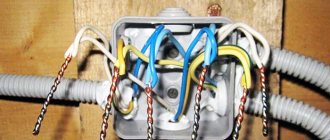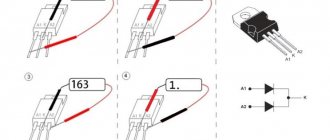Construction and other work cannot be done without power tools. To ensure they are safe to use, they should be tested regularly. Timely diagnostics of power tools reduces the risk of short circuits and extends the life of devices.
Before starting work, tools must be tested
Power tool testing
Megohmmeter for checking power tools The
examination technique includes the definition of verification and verification. At each stage, a certain algorithm of actions has been adopted, which must be strictly followed.
Verification means testing in an electrical laboratory:
- Determine the presence of a grounding branch using an ohmmeter. In this case, one terminal of the device is connected to the plug, the other is connected to the grounding cable. Measure the ohmmeter readings.
- Check the quality and integrity of the insulation . A megohmmeter measuring device is also used for this. Its readings should not be more than 500 V voltage for units whose functional voltage is 220 V. The device also shows the insulation resistance when the instrument key is pressed. If the indicator is more than 500 kOhm, the power tool receives permission to operate; if less, operation is prohibited.
- Conduct idle test
The check consists of inspecting a drill, grinder, and other types. In the process they examine:
- Integrity of the body . They identify cracks, chips, and check joints. Shell parts should not move away, wobble, or be rotated in the plane. No grease drips are allowed on the box.
- Damage to the power cord. There should be no dry areas, rubbing, or signs of burning. The junction of the cable to the housing is formed by a protective tube. The length of this element is 5 times the thickness of the wire.
- Plug condition. Pay attention to the contact protrusions for inclusion in the network. Traces of melting and soot are detected on the device.
Moving parts, for example, chucks for a hammer drill, drills or wheels for an angle grinder, as well as handles must be securely fastened. The coatings on the brush holders are undamaged and in good condition.
Insulation resistance measurement
This procedure is performed using a megohmmeter. Device requirements :
- output voltage – 1000 V;
- the date of the next verification has not expired (indicated on the label attached to the device body, after the words “Best before...”);
- absence of dirt and visible mechanical damage (cracks, chips) on the device body.
The measurement is carried out by a team of two people, the electrical safety group of one of them should not be lower than III . Before starting work, you need to check the megohmmeter .
To do this, you need to short-circuit the terminals of the device , rotate the handle until the arrow on the scale approaches 0. Then you need to disconnect the terminals and rotate the handle again . The instrument needle should deflect towards ∞.
Measurement procedure:
- The terminals of the device are connected to the plug pins of the power tool being tested. It is necessary to pay attention to the fact that the terminal tips of the device do not touch each other . Depending on the type of megohmmeter, you need to rotate the handle of the device or press the button for 1 minute. Record the megohmmeter readings, stop measuring, disconnect the leads.
- Fix one of the device terminals on the pin of the tool plug, the second - on a metal part of the tool body. Carry out the measurement within 1 minute , record the instrument reading, and stop the measurement.
- Connect the terminal of the device to another pin of the tool plug; do not touch the terminal of the device previously connected to the metal part of the tool body . Carry out the measurement for 1 minute, record the instrument reading, stop the measurement, disconnect the leads.
The insulation resistance is considered normal if the measured value exceeds 0.5 MΩ.
If at least one of the measurements shows a lower value of insulation resistance , the tested power tool is rejected (entry “Unsatisfactory” in the corresponding column of the journal).
If all three measurements of the insulation resistance of the tool showed satisfactory results , an entry is made in the appropriate column of the journal, recording the date of the test and its result (satisfactory).
Checking the serviceability of grounding
The test is only effective for Class 1 power that are equipped with a plug with a grounding terminal. Through this contact, the tool body is connected to the PE bus of the supply line.
For diagnostics, highly specialized ohmmeters . They measure resistance and transfer some electricity to the circuit under test. Measure between the box and the ground pin on the plug. The acceptable result should be up to 0.5 Ohm .
Ohmmeters and megohmmeters, in turn, are also tested at standardized intervals and subjected to metrological testing in a laboratory with an electrical certificate.
Classification of electrical tools by degree of protection:
- 0 - class is equipped only with insulation without grounding contacts on the plug, connections or devices;
- 01 - there is functional insulation and a grounding part, but the cable itself does not have a grounding conductor inside;
- 1 - the supply wire has a grounding conductor, insulation and a corresponding contact on the plug;
- 2 - not only the wiring, but also conductive parts are insulated (double protection), the box is made of dielectric;
- 3 - class operates only at a safe reduced voltage (42 V), grounding of parts of the tool is not performed, this includes a battery type or one operating on a battery.
For household and industrial work, classes 1 and 2 are more often used.
Finishing.
Electrical tools are checked and tested quite often, according to regulations. For example, “Inter-industry rules on labor protection in retail trade” indicate: “8.5.30.
Accessories. Repair. Installation. Choice. Opening
PTEEP and POT R M are written in blood... It sounds terrible, but that's how it is. Behind every line there are human victims.
Neglect of safety rules leads to tragedy. According to statistics, most often the victims of accidents in electrical installations are experienced electricians with extensive work experience and a high electrical safety group. A person believes in his professionalism so much that he ceases to be afraid - and this is the sad result. At any enterprise, questions Electrical safety must be handled by a specially trained person responsible for electrical equipment.
This is not a position, but an “honorable duty,” as Rostechnadzor inspectors joke. Let’s quote PTEEP: “1.2.3.
To directly fulfill the responsibilities for organizing the operation of electrical installations, the head of the Consumer (except for citizens who are owners of electrical installations with voltages above 1000 V) appoints with the appropriate document the person responsible for the electrical equipment of the organization (hereinafter referred to as the person responsible for the electrical equipment) ... The person responsible for the electrical equipment and his deputy are appointed from among the managers and specialists of the Consumer.” It is this specialist who is responsible for conducting special and organizing measurements and testing of power tools. Electric impact wrenches, electric drills, electric planers, grinding and polishing machines and other electrified mechanisms that are not fixed to a permanent foundation, as well as electric extension cords and portable lamps - all this portable power tool. Before entering into the results of measurements and tests, these actions must be performed.
Inspection and Test Frequency
The inspection must be carried out before the start of electrical installation work , as well as after its completion. They check the compliance of electrical devices with state standards, technical specifications (technical conditions), and standards that apply at the workplace of a particular enterprise.
Frequency of checking power tools:
- Once a month, hand-held devices are examined for a break in the ground wire, a short circuit on the unit box, or damage to the insulating sheath are detected. They check it with a laboratory calibrated ohmmeter, about which there is a corresponding tag.
- Once every 6 months , the body is inspected to identify mechanical potholes and damage. To do this, practice running the device idle for 5 minutes and selectively determining the insulation resistance. They also check the resistance of the windings and cord, and the defect-free grounding (at 12 V).
Before starting work, check: the date of the last test, compliance of the current frequency and voltage with those of the electric motor. In case of work in extreme conditions, with overloads, you need to check the tool with an ohmmeter every 10 days.
After the overhaul, the following are checked: error-free assembly, serviceability of the grounding circuit, electrical strength of the insulating shell. Run-in in standard mode for half an hour.
Verification
Verification does not need to be carried out frequently; once every 10 days is sufficient for frequent use.
- Connecting to the “ground” contact on the plug and to the “ground” of the ohmmeter tool to measure the performance of the grounding conductor;
- Measurement of electrically conductive insulation when the instrument is loaded (keep the power button pressed while taking measurements);
- Measuring insulation resistance with a test megohmmeter.
- In addition to electrical measurements, it is also necessary to conduct a visual inspection of the housing, cable and moving parts of electrical appliances.
Megohmmeter for measuring resistance
Who should conduct the inspection?
The instrument is tested at enterprises where there is a stationary laboratory equipped for this purpose and where trained employees work. If there are no conditions, contact licensed organizations . Periodic inspections are carried out by specially appointed personnel who have an electrical safety group of at least III.
The electrical safety group means a system of regulatory requirements PTB and PTEEP for employees of the electrical department, operational workers and shows the authority to service electrical tools and installations.
Qualified workers must know:
- the principle of operation of electrical engineering, the procedure for its technical service;
- electrical safety rules, work permits, test standards;
- requirements for supervision of the operation of electrical installations and tools.
The group is assigned in accordance with Order 328, which replaced the previously existing Appendix No. 1 to the Intersectoral Labor Safety Standards. The staff is trained, after which the workers take an exam. The category rank is recorded in a special certificate - a document giving the right to service and testing.
Labor protection rules when working with tools and devices
Appendix to the order of the Ministry of Labor and Social Protection of the Russian Federation dated » ____ » __________ 2014 N _____1.
(hereinafter referred to as the Rules) establish state regulatory requirements for labor protection when working with tools and devices. The Rules are binding on employers - legal entities and individuals, regardless of their organizational and legal forms and forms of ownership, carrying out work using tools and devices, with the exception of employers - individuals who are not individual entrepreneurs. Tools and devices in the Rules mean objects, devices, mechanisms, machines used to influence an object, change it and moved by an employee during the performance of work. The scope of distribution and application of the Rules includes tools and devices , used in all types of economic activities.2. The employer must ensure control over compliance with the Rules. Based on the Rules, labor protection instructions are developed for professions and types of work performed, which are approved by the employer’s local regulations, taking into account the opinion of the relevant trade union body or other representative body authorized by employees (if any). 3.
The choice of collective and individual protective equipment must be made taking into account the safety requirements for each specific type of work and profession.4.
TO
Design and filling out the journal
The power tool inspection log is maintained by a designated responsible employee, who simultaneously monitors the timeliness of inspections, identifies device deficiencies, and prepares power tools for future inspection.
The following information is entered into the log:
- surname of the responsible employee;
- date of the last and next inspection;
- results of diagnostics, visual inspection, insulation testing, grounding circuit defects;
- type of test (periodic, unscheduled, after repair, upon purchase);
- inventory number or factory serial marking, tool name.
The name and serial numbers must exactly match the technical data sheet of the product. The columns are filled out in order so that there are no errors in the information. For new devices, the date of the previous inspection is recorded in the passport.
Conclusions on the topic of publication
The verification procedure should not be ignored. It is best to contact a specialized company, where you will receive qualified assistance for a reasonable fee. A faulty tool can cause injury, so it is always best to know its current condition in advance.
As with anything, you must use logic and common sense when working with power tools. You don’t need to rely only on your own confidence and intuition, just as you don’t need to hope that the tool won’t let you down. It is better to have a reliable guarantee everywhere and in everything.
Any construction and repair cannot be done without hand tools; this simplifies and speeds up its implementation. In this case, portable power tools are most often used as the most reliable and mobile. Electrical energy is one of the most widespread around the world; it is used both in domestic and industrial environments. However, not every master knows that electric tools must be checked regularly so that they do not cause an accident involving electric shock or an explosion (fire) when working in hazardous fire conditions. In this article we will tell you how to check a power tool, how often it should be done and who should do this type of work.
Is it necessary to test new dielectric gloves, boots, galoshes, tools???
We are often asked why test dielectric gloves, because it is easier and cheaper to buy new ones. But it's not that simple. There are rules that must be followed.
INSTRUCTIONS FOR USE AND TESTING OF PROTECTION MEANS USED IN ELECTRICAL INSTALLATIONS WITH 153-34.03.603-2003
1.4.4. Electrical protective equipment, except for insulating stands, dielectric carpets, portable grounding, protective fences, posters and safety signs, as well as safety belts and safety ropes received for operation from manufacturers or warehouses, must be tested according to operational test standards.
Our company’s stationary high-voltage electrical laboratory tests the following protective equipment:
- dielectric gloves;
- rubber dielectric boots and galoshes;
- hand insulating tool;
- insulating rods;
- insulating and electrical clamps;
- voltage indicators;
- insulating stands and caps;
- portable grounding.
After commissioning, PPE and power tools are subject to periodic and extraordinary testing. Extraordinary tests are carried out after repairs, replacement of components, or when a malfunction is detected. All tests of dielectric rubber protective equipment
, power tools, rods, voltage indicators are carried out in accordance with the document “Rules for the use and testing of protective equipment used in electrical installations, technical requirements for them” and state standards. Before testing, an external inspection is carried out. If any defects are detected or the PPE is incomplete, it is considered faulty and testing is stopped. If the external examination gives a positive result, the product undergoes testing, including control of mechanical and electrical characteristics.
Responsibility
In accordance with Article 9.1 of the Code of Administrative Offenses of the Russian Federation, violations in the field of operation of electrical equipment are punishable by fines:
- for individuals - from 1000 to 2000 rubles;
- for officials - from 2000 to 4000 rubles;
- for individual entrepreneurs - from 2000 to 4000 rubles or suspension of activities for up to 90 days;
- for legal entities - from 20,000 to 40,000 rubles or suspension similar to individual entrepreneurs.
The lack of mandatory documentation is one of the violations, and the manager needs to decide: download the electrical equipment logbook (filling sample) for free and use it, thereby fulfilling the requirements of the Rules for the Technical Operation of Electrical Installations, or risk being fined a large amount.











